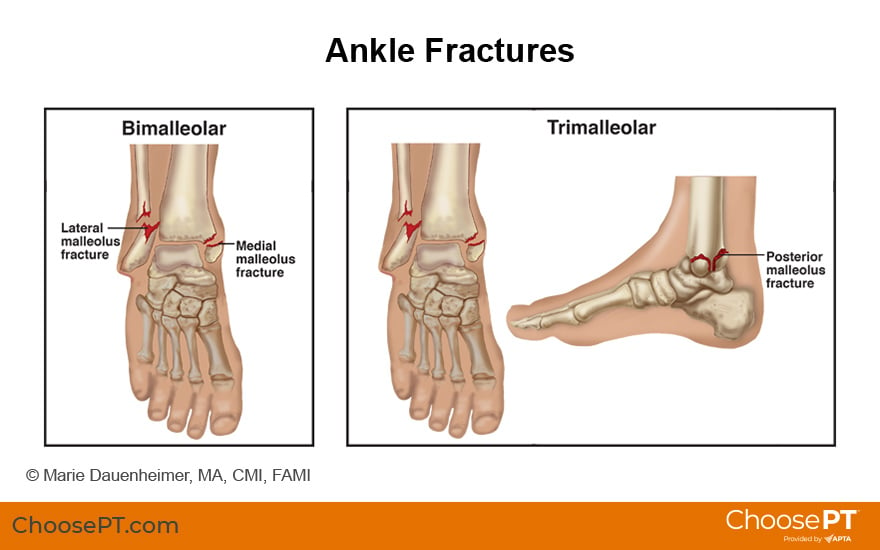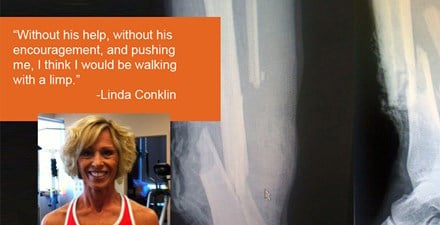Physical Therapy Guide to Ankle Fracture
An ankle fracture occurs when a bone on one or both sides of the ankle is partially or completely broken. Most ankle fractures result from falls, jumps, sports, exercise, or trauma. In males, most ankle fractures occur between the ages of 10 and 19. Females experience more ankle fractures overall in all other age groups. Fracture types may vary from simple to complex. They may involve one, two, or three fracture areas. It is essential to seek evaluation after an ankle injury to determine if you have a fracture. Physical therapists play an important role in helping people recover from ankle fractures. They can help you return to regular activities in the safest and fastest way possible.
Physical therapists are movement experts. They improve quality of life through hands-on care, patient education, and prescribed movement. You can contact a physical therapist directly for an evaluation. To find a physical therapist in your area, visit Find a PT.
What Is an Ankle Fracture?
An ankle fracture is when a bone on one or both sides of the ankle joint breaks, completely or partially. There are several ankle fracture types based on the number of bones broken. They are:
- Lateral malleolus fracture. Only the fibula (the bone on the outside of the ankle) breaks.
- Medial malleolus fracture. Only the tibia (the bone on the inside of the ankle) breaks.
- Bi-malleolar fracture. Two bones break: the fibula and the tibia.
- Trimalleolar fracture. Fractures occur at three sites: the fibula, tibia, and the posterior malleolus (located on the back of the tibia).

Fractures are measured in severity by whether they are:
- Nondisplaced. The pieces of the broken bone remain lined up.
- Displaced. The two parts of the broken bone do not line up.
- Comminuted. The bone or bones splinter, or small pieces of bone break off.
- Complex fracture. There is severe damage to the soft tissue surrounding the broken bone(s).
- Compound fracture. Fracture fragments pierce the skin.
When a fracture involves several broken bones, or the bones do not line up, the fracture is unstable and requires immediate treatment. There also is a higher risk for infection for individuals with a compound fracture.
Signs and Symptoms
People who fracture their ankles may experience:
- Immediate, severe pain after a twisting injury or fall.
- A "pop" or "snap" felt or heard at the time of injury.
- Swelling, bruising, tenderness, or pain in the ankle or lower leg.
- A visible bump or deformity in the ankle or lower leg.
- Difficulty or inability to bear weight on the ankle.
- Pain that increases with activity and improves with rest.
- Inability to put a shoe on due to swelling and pain.
How Is It Diagnosed?
Ankle fractures are diagnosed using an X-ray and a physical exam.
If you see a physical therapist first, they will perform a full evaluation. It will include questions about your medical history, how your injury occurred, and a physical exam. Your physical therapist will observe your ability to walk and bear weight on the injured ankle and examine the area for swelling, deformity, and tenderness. They also will assess your foot and lower leg to find out if other areas may be injured.
If an ankle fracture is suspected, your physical therapist will refer you for an X-ray. If the X-ray reveals a fracture, you will be referred to an orthopedic doctor, podiatrist, or the emergency room for further treatment. It is important to have an ankle injury assessed by your physical therapist or doctor soon after your injury to determine whether you have a severe ankle sprain or a broken bone.
If the bone pierces the skin, go immediately to a hospital emergency room.
How Can a Physical Therapist Help?
When ankle fractures require immobilization using casting or a protective boot, or the use of crutches to get around, your joints can become stiff. Also, sometimes surgery and casting are needed to repair a fracture. Whether or not you have surgery, a physical therapist can help restore proper joint movement and flexibility after your cast comes off. Physical therapy also can help you safely regain strength in the ankle you have not used during casting.
Before Surgery
If you have an ankle fracture, treatment will depend on the number of broken bones and whether you have a simple, complex, or compound fracture. Initial treatment involves realigning and stabilizing the bones by a doctor, often with a cast. This treatment will be done in the hospital emergency room or, if needed, with surgery.
If you require surgery, you may see a physical therapist prior to surgery, who will:
- Instruct you in acute injury care.
- Immobilize your ankle by wrapping it with an ace wrap or applying a stirrup brace to limit motion and control swelling.
- Apply ice to reduce pain and swelling.
- Instruct you to keep the injured ankle elevated to control swelling.
- Instruct you to walk without putting weight on the injured ankle, using crutches or a walker.
- Recommend further care by an orthopedic doctor or emergency department.
After Surgery
If your ankle fracture requires surgery, your doctor will cast it or provide you with a fracture boot to stabilize it post-surgery. A physical therapist will visit your hospital room once you are medically stable. They will help you sit on the bedside, get up and out of bed, and then balance to stand on your uninjured leg. The surgeon will give instructions as you may or may not be allowed to put any weight on the involved ankle for about six to 10 weeks. Your physical therapist will teach you how to walk using crutches or a walker and manage steps and curbs.

When an X-ray confirms that the fracture has healed, your doctor will remove your cast. Your physical therapist will work with you to safely progress to putting weight on your ankle. They will begin treatment to help you gain back your strength, range of motion, balance, and sports skills so you can return to your regular activities.
If You Do Not Need Surgery
A physical therapist can help treat a broken ankle after repair by a doctor, who will use casting to realign the bone, or apply a boot. Once the bone heals, a physical therapist can help you gain back your strength, range of motion, balance, and sports skills.
While your ankle is in a cast and you cannot bear weight on it, your physical therapist can teach you how to walk using crutches or a walker. They will teach you how to get in and out of bed and your car, and use stairs. Your physical therapist will provide you with the equipment that best suits your needs.
When an X-ray shows that your bone has healed enough, your doctor will remove your cast. You then will begin bearing weight on that leg and continue or begin your physical therapy treatment.
Your treatment plan may include:
- Patient education. Your physical therapist will educate you about your ankle fracture to assist you in making decisions. They will suggest changes to the type and amount of exercises you do, your athletic activities, and your everyday functions. They also will develop and teach you how to perform a personalized exercise program to help ensure a pain-free return to your desired activities.
- Pain management. Your physical therapist will design a program to address your pain that can include applying ice to the affected area. They also may recommend modifying some activities that cause pain. Physical therapists are experts in prescribing pain-management techniques that reduce or eliminate the need for medication, including opioids.
- Walking instruction. Your physical therapist will help you begin to put some of your weight on the injured leg based on your level of healing. According to the timing your doctor recommends, they will help you safely and gradually progress to bearing full weight on your injured ankle.
- Gait training. Your physical therapist will offer specific instructions and exercises to restore a normal walking pattern. They will focus on how your foot and ankle move and the timing of your steps. They may have you practice on a treadmill at low speed, on level ground, and on steps.
- Reducing swelling. Swelling is common after an ankle fracture. Treatment to reduce swelling may include gentle massage. Your physical therapist also may recommend and teach you the right way to use a compression wrap, apply ice or heat, and elevate the affected ankle when at rest.
- Range-of-motion exercise. After an ankle fracture, your ankle and foot mobility can be limited, causing increased stress to the region and other areas. Your physical therapist may teach you self-stretching techniques to decrease tension and help restore normal motion of your lower-extremity joints, from the pelvis/hip region down to your foot.
- Manual therapy. Your physical therapist may treat your condition by gently applying "hands-on" treatments to move your muscles and joints (manual therapy). These techniques help improve movement. Your physical therapist also may use manual therapy to guide the region into a less stressful movement pattern. Your physical therapist also can provide resistance to specific movements to improve strength that may be limited.
- Muscle strengthening. Muscle weaknesses or imbalances can develop after immobilization and not putting weight on the leg. These can contribute to a loss of function and continuing symptoms. Based on the seriousness of your symptoms, your physical therapist will design a safe, personalized, progressive resistance program for you. You may begin by doing strengthening exercises lying on a treatment table, or at home on the bed or floor. You then may advance to doing exercises in a standing position. Your physical therapist will choose the right exercises for you based on your age and physical condition.
- Functional training. Once your pain, strength, and movement improve, you will need to safely transition into more demanding activities. It is important to learn safe, controlled movements to minimize stress on your ankle and foot. Based on your movement assessment and goals, your physical therapist will create a series of activities to help you learn how to move your body correctly and safely.
- Assistive devices. Your physical therapist or other members of the health care team may recommend using assistive devices to aid in your recovery, such as:
- Using a cane, walker, or crutches to reduce pain and improve your walking ability for a specific period, depending on the severity of your ankle fracture.
- Bracing your ankle to stabilize it during the initial recovery. Your physical therapist will help fit you with a brace and teach you how to use it.
- Wrapping the ankle and foot to help reduce swelling. Your physical therapist may recommend specific wrapping techniques or the use of compression stockings.
Return to full participation in sports and work activities generally occurs 12 to 16 weeks after an ankle fracture.
Note: Physical therapy treatment and recovery times differ for each person. This will depend on your type of injury, how well you are healing, and whether you had surgery. Your age and physical health will also be factors.
Can This Injury or Condition Be Prevented?
Not all ankle fractures can be prevented. However, you can take the following precautions to reduce your risk of an ankle injury:
- Wear appropriate protective gear when participating in sports.
- Train to reach your top strength and fitness levels.
- Wear proper shoes, and replace athletic shoes regularly.
- Maintain adequate vitamin D and calcium levels.
- Strengthen your ankle muscles. Your physical therapist can design a strengthening program to fit your needs and goals.
You also can do the following practical things to reduce your risk of falling:
- Remove obstacles and clutter from hallways and rooms in your home.
- Work and play in well-lighted areas.
- Use night lights in the home.
- Install grab bars in tub and shower areas.
- Add railings to both sides of stairways.
- Maintain strength and fitness throughout your life.
What Kind of Physical Therapist Do I Need?
All physical therapists are prepared through education and experience to treat ankle fractures. However, you may want to consider:
- A physical therapist who is experienced in treating sports injuries or orthopedic conditions. Some physical therapists have a practice that focuses on sports medicine and orthopedics.
- A physical therapist who is a board-certified clinical specialist or who completed a residency or fellowship in orthopedics and sports physical therapy. This physical therapist has advanced knowledge, experience, and skills that may apply to your condition.
You can find physical therapists in your area with these credentials and clinical expertise on Find a PT, a tool built by the American Physical Therapy Association.
General tips when you are looking for a physical therapist (or other health care provider):
- Ask family, friends, and other health care providers to recommend a physical therapist.
- Ask about the physical therapist's experience treating ankle fractures or orthopedic injuries before you make an appointment.
- Be prepared to describe your symptoms in as much detail as possible on your first visit, including what makes your symptoms better or worse.
The American Physical Therapy Association believes that consumers should have access to information to:
- Inform their health care decisions.
- Prepare them for their visit with a health care provider.
The following resources offer some of the best scientific evidence related to physical therapy treatment for incontinence. They report recent research and provide information on the standards of practice in the United States and internationally. They link to a PubMed* abstract (which may offer free access to the full text) or other resources. You can read them to learn more or bring a copy to your health care provider.
Scheer RA, Newman JM, Zhou JJ, et al. Ankle fracture epidemiology in the United States: patient-related trends and mechanisms of injury. J Foot Ankle Surg. 2020;59(3):479−483. Article Summary on PubMed.
Alshamrani HA, Alloub H, Burke D, Offiah AC. Vitamin D intake, calcium intake and physical activity among children with wrist and ankle injuries and the association with fracture risk. Nutr Health. 2019;25(2):113–118. Article Summary on PubMed.
Jansen H, Jordan M, Frey S, Hömlscher-Doht S, Meffert R, Heintel T. Active controlled motion in early rehabilitation improves outcome after ankle fractures: a randomized controlled trial. Clin Rehabil. 2018;32(3):312–318. Article Summary on PubMed.
Warner SJ, Garner MR, Nguyen JT, Lorich DG. Perioperative vitamin D levels correlate with clinical outcomes after ankle fracture fixation. Arch Orthop Trauma Surg. 2016;136(3):339–344. Article Summary on PubMed.
*PubMed is a free online resource developed by the National Center for Biotechnology Information. PubMed contains millions of citations to biomedical literature, including citations in the National Library of Medicine's MEDLINE database.
Expert Review:
Apr 14, 2022
Revised:
Jun 9, 2022
Content Type: Guide
Ankle Fracture
PT, board-certified clinical specialist in orthopaedic physical therapy
Lisa Noceti-DeWit
PT, DPT, board-certified clinical specialist in orthopaedic and sports physical therapy
Stephen F. Reischl
PT, DPT, board-certified clinical specialist in orthopaedic physical therapy, on behalf of the Academy of Orthopaedic Physical Therapy
You Might Also Like...
Patient Stories
Traumatic Leg Injury Recovery: Linda's StoryOct 17, 2013
"I honest to God would not be where I am today" without my physical therapist.
